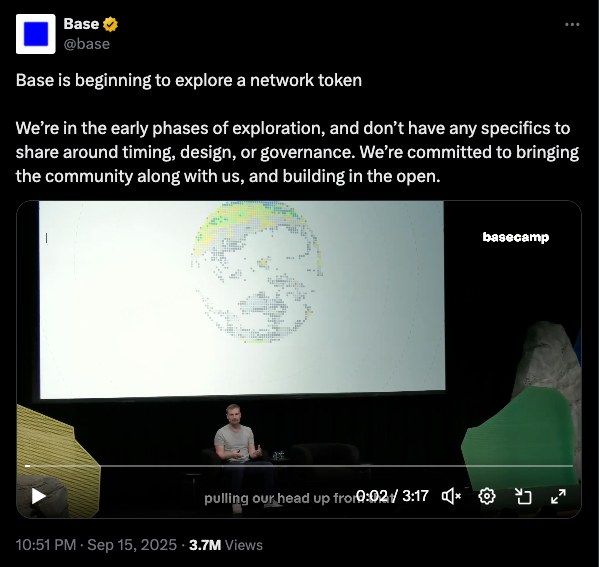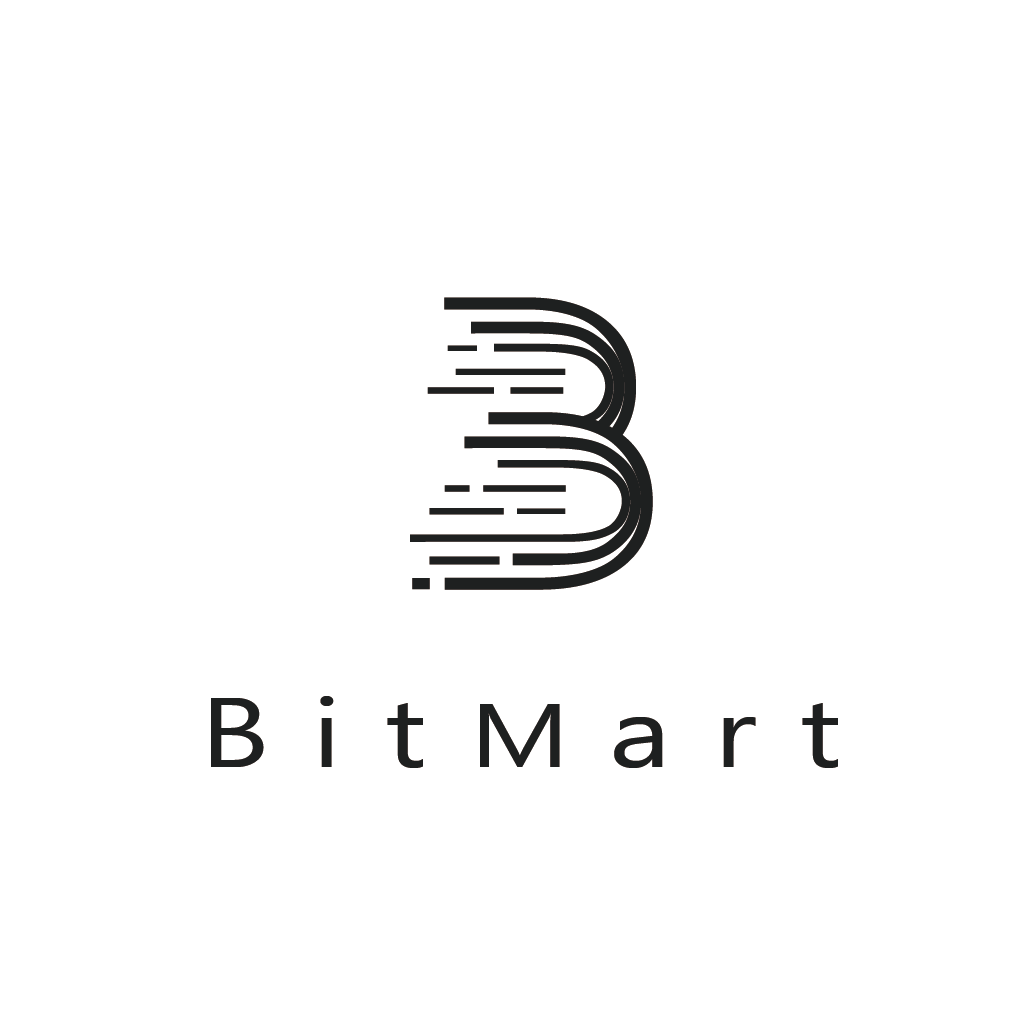Base explores token issuance: Layer 2 faces its strongest competitor.

I. Base Begins Exploring Cryptocurrency Issuance: From "Never Will Issue One" to "Under Research"
In September of this year, Jesse Pollak, head of the Base network, first hinted at the BaseCamp conference that Base was actively exploring the possibility of issuing a native token. Shortly after, Coinbase co-founder and CEO Brian Armstrong stated: "We are exploring issuing a native token for the Base network." Since its launch in 2023, Base has adhered to a "no native token issuance" strategy, focusing on infrastructure and developer tools. The team's priority is clear: to build a secure, low-cost, and developer-friendly chain and ecosystem.
This recent major shift has quickly generated a huge response throughout the cryptocurrency community, marking a significant change for Base from a "no-token" strategy to a "potential token issuance." Although Base still emphasizes that "there is no final timetable, model, or allocation plan," token issuance has moved from a "possibility" to a "public agenda."

II. Why issue cryptocurrency? To address external competition through structural restructuring.
Base's decision to issue a token was not a spur-of-the-moment decision, but a strategic turning point made at a critical moment. Whether from the perspective of funding, competition, technology, or the regulatory environment, issuing a token has changed from "whether to do it" to "must do it now."
1. Capital continues to flow out; without issuing new tokens, it's impossible to retain users.
Over the past six months, Base's funds have been flowing out, with a net outflow exceeding $2.77 billion. For public chains that rely on ecosystem expansion, weak funding means an increased risk of developer and user churn. The ecosystem urgently needs to introduce new incentives through tokens, making token issuance an inevitable choice to overcome liquidity bottlenecks.

2. Use tokens to bind the ecosystem together, forming a true value cycle.
The token can establish a long-term, effective value cycle for Base, binding developers, users, and liquidity within the same system of shared interests. Base's head, Jesse Pollak, has explicitly stated that the goal of issuing the token is to promote network decentralization and provide creators and developers with longer-term, more certain incentives. In the Web3 ecosystem, tokens are the most effective mechanism for coordinating interests, accumulating value, and maintaining vitality. For Base, which is entering its mid-to-late growth phase, issuing the token represents a crucial step in shifting from "usage growth" to "value growth."
3. Competitors are all issuing their own tokens; if Base doesn't, it'll be squeezed out.
The current Layer 2 competition has entered an incentive war. L2 platforms like Arbitrum, Optimism, and Blast have established strong capital cycles through token airdrops and ecosystem incentives, attracting liquidity and driving project growth within their ecosystems. In contrast, while Base's long-term reluctance to issue its own token reinforces its "product-first" narrative, it has gradually fallen behind in DeFi development, liquidity pool expansion, and developer retention. In the incentive-driven L2 landscape, "not issuing a token" is gradually shifting from an advantage to a competitive disadvantage.
4. With a more favorable regulatory environment, Coinbase has finally entered a compliance window.
The biggest obstacle to Coinbase's past reluctance to issue its own token was regulatory risk: if the US were to classify tokens as securities, issuers would face enormous legal costs. As a publicly traded US company, Coinbase could not afford such uncertainty. However, the US political climate has now shifted significantly towards crypto, and the regulatory environment has structurally improved. In this context, Coinbase's compliance capabilities have become an advantage, enabling it to design compliant token models and regulated community structures.
III. What changes will occur to Base after the token is issued?
1. Real community governance will begin to function.
Currently, decision-making power for Base is primarily concentrated in Coinbase. However, with the introduction of tokens, governance power may gradually shift to the community. Token holders will be able to participate in key decisions through voting, including protocol upgrades and fund allocation, truly realizing a community-driven governance model. The rules governing the entire ecosystem's allocation will also become more transparent, marking the true beginning of decentralization.
2. A fully upgraded incentive system will lead to explosive growth.
BASE tokens can incentivize all ecosystem stakeholders:
- Developers: Project subsidies, funding support
- User: Gas discounts, points redemption, airdrops
- Creators: Earn money by creating content on Base
- Liquidity providers: Receive incentives from DEX pools
3. BASE is expected to become the "quote currency" on the Base chain.
While ETH will remain the currency for gas fee payments, BASE is expected to become the primary pricing currency on decentralized exchanges within the ecosystem. This means that most trading pairs will be denominated in BASE, creating stable market demand and solidifying its core position within the Base ecosystem.
4. Institutions may enter the Base ecosystem on a large scale.
Coinbase's institutional resources and compliance capabilities lay the foundation for institutional-grade applications of the BASE token. Institutional investors can use BASE for staking, governance, or as collateral for DeFi protocols. This institutional-grade use case will bring traditional financial market funding and recognition to Base, creating a differentiated advantage over other Layer 2 solutions.
IV. Ecological Projects Worthy of Attention
Aerodrome
Aerodrome, one of the largest DEXs on Base, recently announced a merger and upgrade with Velodrome Finance within the Optimism ecosystem. The integration will create a unified governance and incentive system covering Ethereum, Base, OP, and Arc, becoming the central scheduling layer for cross-chain liquidity. AERO and VELO will be merged into a single token, with existing holders mapped according to their weights, and the new token capturing the revenue of the entire cross-chain network. Dromos is expected to launch on the Ethereum mainnet alongside Arc in Q2 2026, further strengthening its cross-chain strategy.
Zora
Despite the decline in meme popularity, Zora remains one of Base's largest and most active content and token issuance platforms. Its unique creator-issued token model continues to attract community participation. Recently, Base founder Jesse launched his first personal token, $jesse, on Zora; however, due to the sluggish market, its market capitalization is currently hovering around $17 million.
Avantis
This year, the Perp DEX sector has seen explosive growth, driven by Hyperliquid and Aster, with Avantis emerging as one of the fastest-growing and most active Perp DEXs in the Base ecosystem. As the sector continues to expand, Avantis's position within Base warrants continued attention.
Limitless
Prediction markets are one of the hottest sectors this year. As a Coinbase-backed project, Limitless has grown into the largest prediction platform within the Coinbase ecosystem. If leading players in the sector like Polymarket and Kalshi issue their own tokens, the price of LMTS is expected to see further growth.
Virtuals
One of the largest AI Agent launch platforms in the market, Virtuals once led a market boom with its "staking participation in IPOs" model. Although its performance has weakened in the short term due to the cooling down of memes, AI Agents remain a super hot sector, and Virtuals has a first-mover advantage, making it worthy of close attention in the future.
V. Issuing Base tokens is not the end, but the beginning.
Overall, Base's token issuance is a significant boon for the ecosystem, users, and developers, marking a crucial step towards the maturity of its infrastructure. In the blockchain world, technology and ecosystem are undoubtedly important, but without token incentives, it's like building a city without an economic system—users and developers will find it difficult to stay long-term. Tokens not only carry value but also drive the ecosystem's cycle, allowing participants to see tangible benefits, thus ensuring a truly vibrant ecosystem.
BNB is a prime example: this year, its collaboration with FourMeme and Binance Alpha attracted a large number of users and funds. As the underlying token, BNB allows the value of ecosystem innovation and short-term hype to ultimately flow back to the underlying asset, forming stable demand and long-term growth. In contrast, while Base boasts popular projects like Zora and Virtuals that can ignite the market in the short term, the lack of a native token means user rewards primarily flow to the projects themselves, making it difficult to accumulate long-term value for the Base chain. Consequently, its active ecosystem cannot be translated into sustained growth.
Issuing tokens can change this situation, establish a complete value cycle, and tightly bind users, developers, and ecosystem projects, ensuring that every participation and every transaction leaves real value on the chain, forming a virtuous cycle of "ecosystem activity—value accumulation—user retention." This not only sustains short-term popularity but also gives Base a unique advantage in the fierce Layer 2 competition, upgrading it from a technically friendly chain to an ecosystem platform with both economic dynamism and long-term potential.
Risk warning:
The information above is for reference only and should not be considered as advice to buy, sell, or hold any financial assets. All information is provided in good faith. However, we make no representations or warranties, express or implied, regarding the accuracy, adequacy, validity, reliability, availability, or completeness of such information.
All cryptocurrency investments (including financial products) are inherently highly speculative and carry a significant risk of loss. Past performance, hypothetical results, or simulated data are not indicative of future outcomes. The value of cryptocurrencies may rise or fall, and buying, selling, holding, or trading cryptocurrencies may involve significant risks. Before trading or holding cryptocurrencies, you should carefully assess whether such investments are suitable for you based on your investment objectives, financial situation, and risk tolerance. BitMart does not provide any investment, legal, or tax advice.
- 核心观点:Base战略转向探索发行原生代币。
- 关键要素:
- 资金外流超27亿美元需激励。
- 代币可绑定生态建立价值循环。
- L2竞争激烈倒逼发币应对。
- 市场影响:增强生态激励与L2竞争力。
- 时效性标注:中期影响。



